Dash Price Analysis - Inflation set to decrease by 7% next month
DASH (DASH) is a cryptocurrency with optional privacy features and a decentralized autonomous organization (DAO) for governance. The coin is down 95% from the all-time high established in December 2017. The market cap is 19th on the BraveNewCoin market cap table and currently stands at US$709 million, with US$256 million in trade volume over the past 24 hours.
The project is a Bitcoin fork created by Evan Duffield in January 2014. The project was originally known as XCoin, was subsequently rebranded to DarkCoin, and ultimately named DASH, and described as Digital Cash, in 2015. Ryan Taylor is the current DASH Core CEO, with Duffield acting as a strategic advisor.
The project uses a two-tiered PoW (PoW) and Proof of Stake (PoS) consensus model. PoW mining verifies the ledger using a two and a half minute block time. PoS occurs through Masternodes and serves higher functioning tasks, including governance and unique sending features. The block rewards are currently split between three entities; 45% goes to PoW miners, 45% to the master nodes, and 10% to the DASH treasury.
Around ~18,000,000 tokens will be mined in total, with block rewards decreasing by 7% per year until no rewards exist. Inflation is currently 6.54% per year (chart below). Upon release in 2014, two million coins were mined on the first day, which some have referred to as an ‘instamine.’ However, only 19.77% of the total circulating supply is currently held by the top 100 accounts, opposed to 15.22% held by the top 100 Bitcoin addresses.
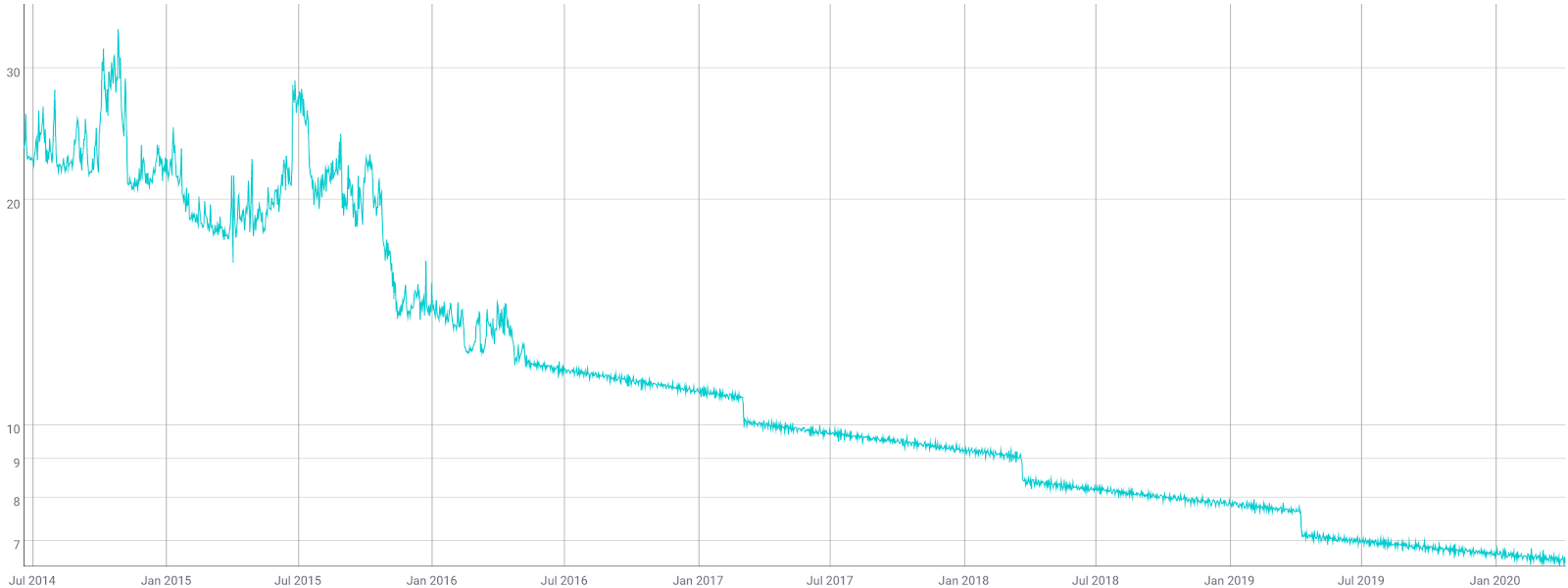
A quick comparison between all coins with privacy capabilities shows that DASH leads in total daily fees, transactions per day, and daily active addresses. Other coins with privacy features include Monero (XMR), Zcash (ZEC), Grin (GRIN), and PIVX (PIVX). Both XMR and GRIN obscure blockchain transaction values and addresses.

On the network side, hash rate and difficulty reached a new all-time high in late January but have decreased 20% over the past few weeks. The network uses the X11 hashing algorithm, which was developed by Duffield, and is comprised of the following hash functions: BLAKE, BLUE MIDNIGHT WISH (BMW), Grøstl, JH, Keccak, Skein, Luffa, CubeHash, SHAvite-3, SIMD, and ECHO. The X11 algorithm cycles through each of the 11 algorithms, in order, during the hashing process.

DASH can be mined by 24 Application-Specific Integrated Circuits (ASICs) currently on the market. Only 11 of the 24 ASICs are currently profitable at US$0.04 per kilowatt-hour (c/kWh). Thus far, there are no X11 ASICs set for release in 2020. Overall, mining profitability is currently sitting near an all-time low, and will decrease further after the inflation reduction next month. Other network factors that influence mining profitability include; price, block times, difficulty, and transaction fees.
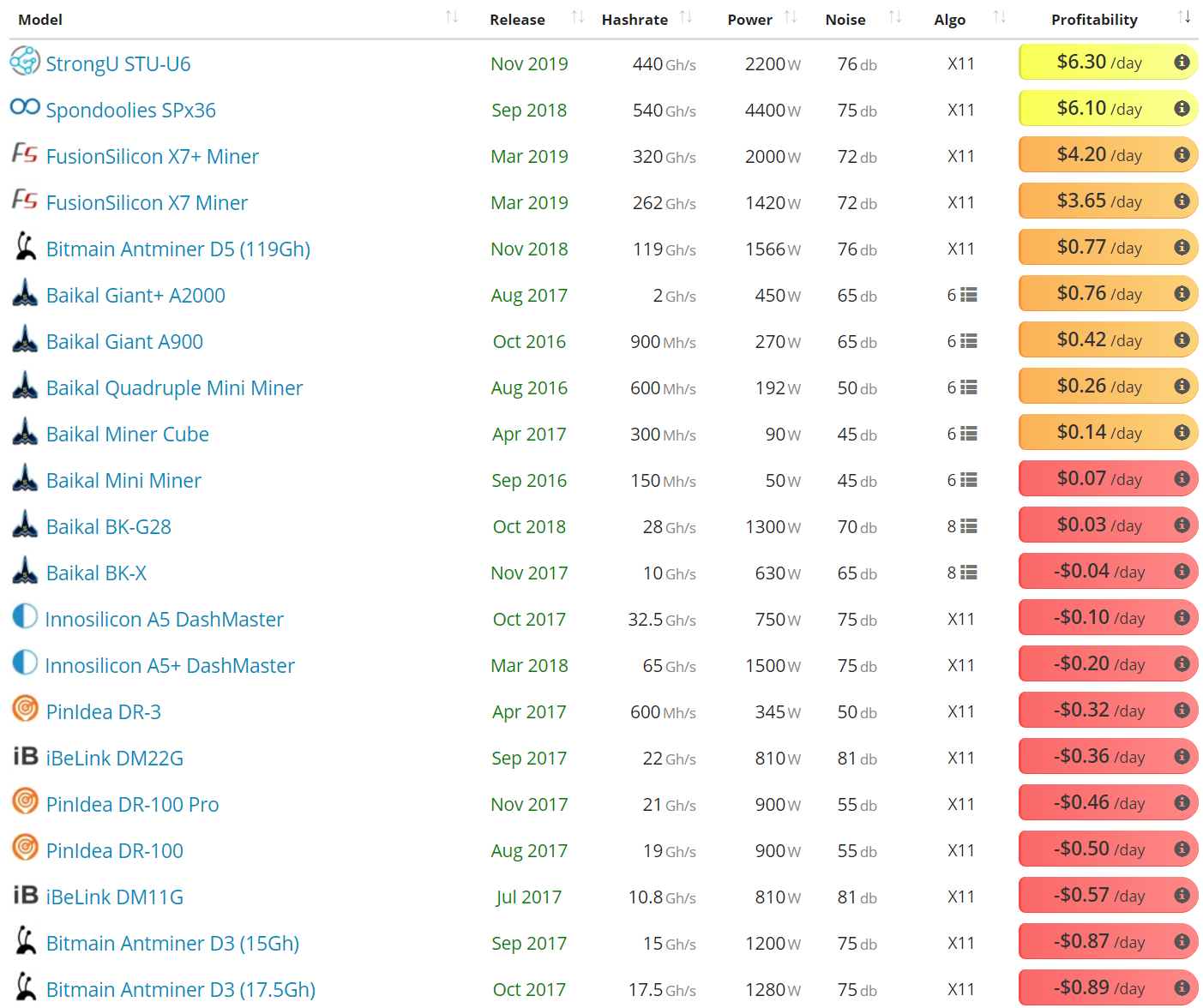
After months of development, the distributed key generation (DKG) update went live in June 2019, enabling the formation of Long-Living Master Node Quorms (LLMQs). The update is designed to enhance the performance and scalability of the network. LLMQ-based ChainLocks provide a protection mechanism against 51% attacks on the network by preventing miners from secretly mining a longer DASH chain and then attempting to re-organize the blockchain.
The protocol change also included a Proof of Service (PoSE) scoring system for each of the network's Master Nodes. A variety of metrics are involved in the calculation, to mitigate gamification of the system, but nodes that fail to respond to ping requests are banned from the network. The node must then be repaired before rejoining the network.
Each Master Node requires 1,000 DASH, currently valued at US$75,000, which acts as collateral during governance functions in order to prevent Sybil attacks or “ballot stuffing.” Despite the price tag and volatility risk, these nodes had increased at a steady rate since 2015. However, this growth has plateaued since January 2019.
There are currently 4,626 Master Nodes on the network, which means over 50% of the circulating supply is currently held as collateral. The Master Node share of the block reward is split between all the nodes, meaning that as node numbers increase, the payout per node decreases.
Master Nodes currently earn 6.63% per year. In comparison, PIVX currently has 1,426 active master nodes, which require 10,000 PIVX as collateral. These nodes are valued at US$2,780 and provide a return on investment of 8.88% with inflation on the network currently running at 4.11%.
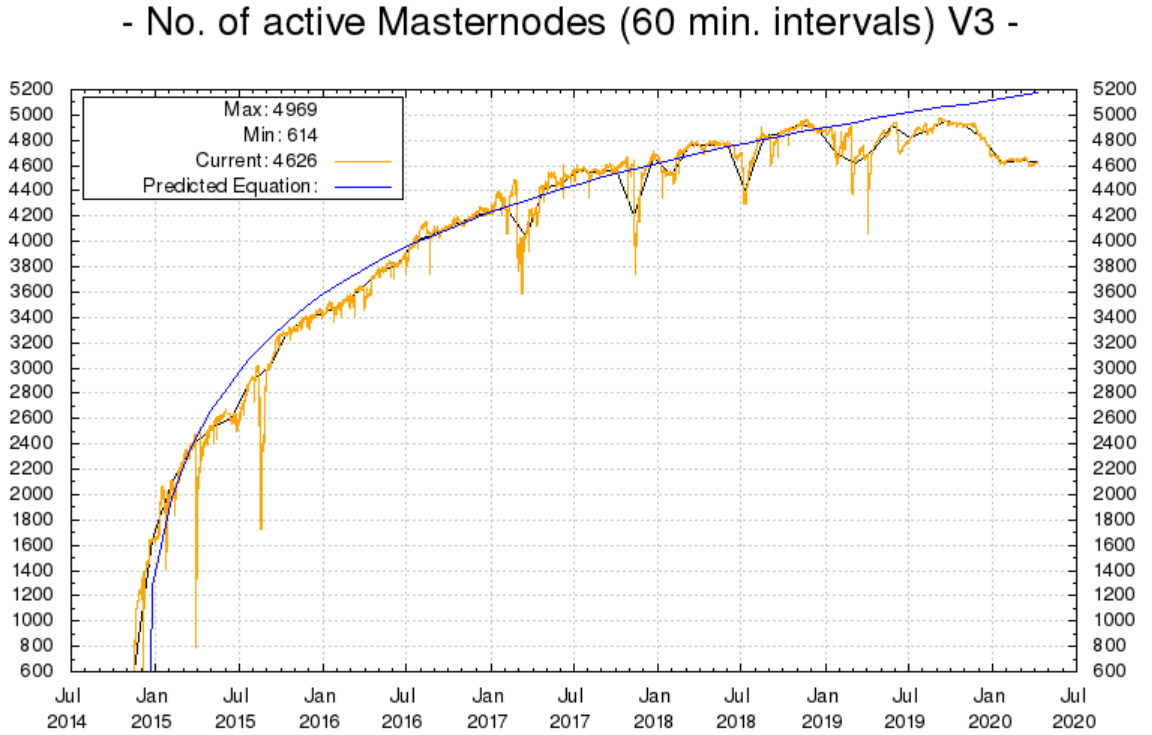
Master Nodes can send transactions using InstantSend or PrivateSend. InsantSend enables a type of off-chain 0-confirmation transaction which bypasses miners entirely. This is done through a transaction locking command with a wallet or client showing an intention to lock funds from a specific input to a specific output.
PrivateSend is essentially a coin mixing service, similar to CoinJoin, which combines identical inputs from multiple users into a single transaction with several outputs. For this reason, DASH is often labeled as a ‘privacy coin,’ along with XMR and ZEC. Although PrivateSend and mixed transactions (charts below) represent a low percentage of overall total transactions, these functions have been steadily increasing since 2015. However, there are far fewer DASH private transactions on the network when compared to XMR or ZEC.
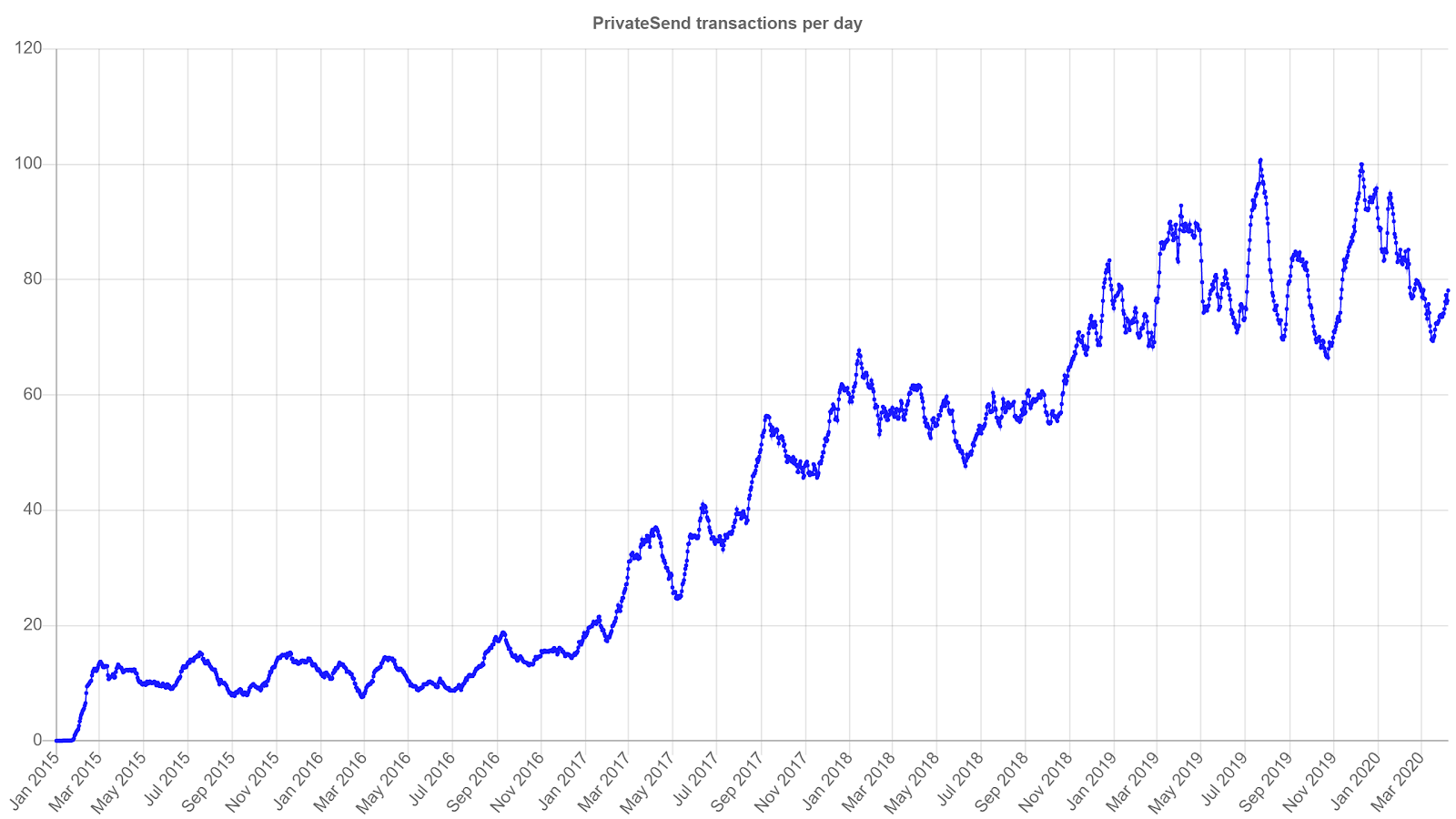

The Master Node governance model also enables a decentralized voting mechanism for DASH related projects, paid for through the treasury block reward. These projects, and their related budgets, are voted on by MNs. Each project, if it passes a vote, is added to the total budget and the person or entity doing the work is paid. While the mechanism has resulted in various projects being funded by the network, a substantial amount of proposals over the past few months focused on marketing and promotion in developing countries.
Largely in part due to Duffield’s local connections, DASH has also funded or partnered with many Arizona based initiatives. In August 2017, the treasury set aside US$50,000 for Blockchain Research Laboratory (BRL), and in November 2017, they assisted Arizona State University (ASU) in opening a BRL at the university. In January 2018, a further initiative with ASU was announced, worth US$300,000, which is aimed at accelerating research, development, and education in the blockchain field.

The total number of transactions per day on the network (line, chart below) has steadily increased since the August 2018 low of 4,800, and is currently 20,000. The transaction spikes represent stress testing periods when more than 3.5 million transactions were sent.
The average transaction value per day (fill, chart below) peaked late in 2017, and has since declined to less than US$100 in January 2019. Since then, the average transaction value has risen slightly, and has ranged from US$150 to US$800 over the past few months. The average transaction fee (not shown) has steadily declined since early 2018, and now stands at US$0.007, which is near a multi-year low. Average transaction fees for XMR, ZEC, GRIN, and PIVX are currently US$0.0148, US$0.0069, US$0.00424, and US$0.0284 respectively.
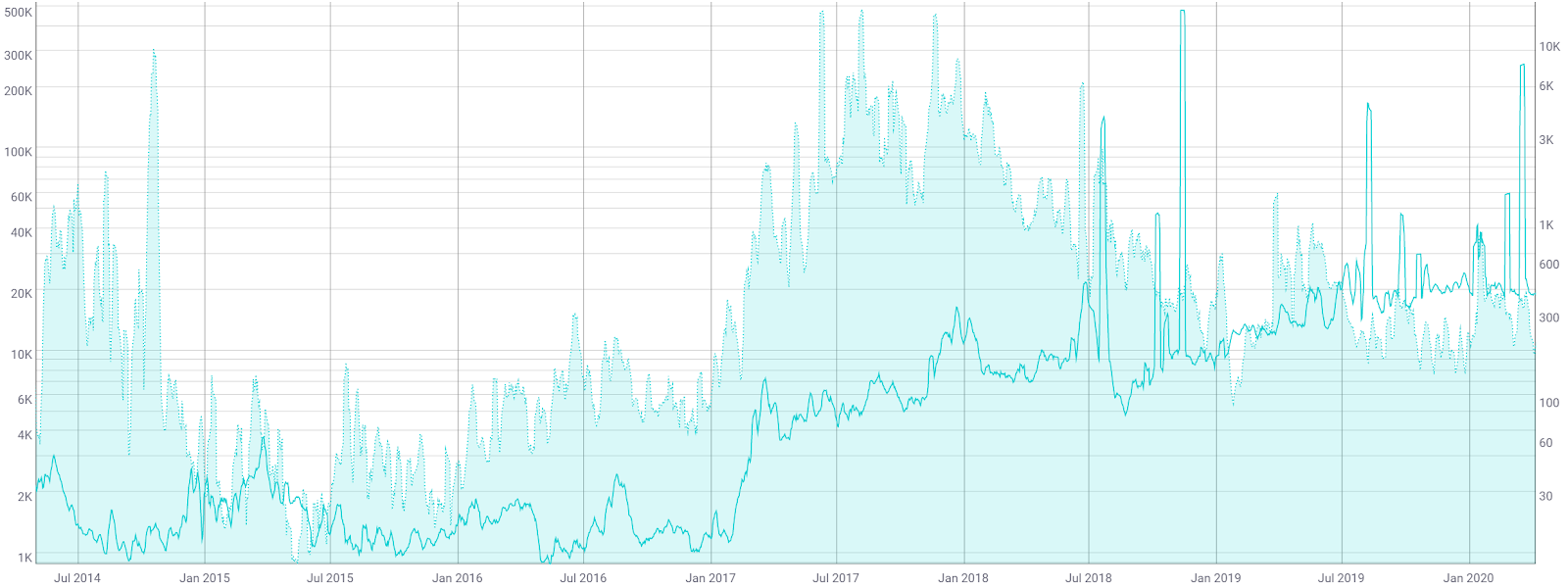
The 30-day network value to estimated on-chain daily transactions (NVT) ratio (line, chart below) has dropped to 60 over the past two months, reaching a multi-year low. Inflection points in NVT can be leading indicators of a reversal in an asset’s value. An NVT held below 20 should signify bullish market conditions. A clear uptrend in NVT suggests a coin is overvalued based on its economic activity and utility, which should be seen as a bearish price indicator, whereas a downtrend in NVT suggests the opposite.
Active and unique addresses are important to consider when determining the fundamental value of the network using Metcalfe's law. Monthly active addresses (fill, chart below) hit an all-time high of nearly 100,000 in July 2019 and January 2020. Active addresses have continued to steadily increase year over year, suggesting sustained and increasing interest in the network.
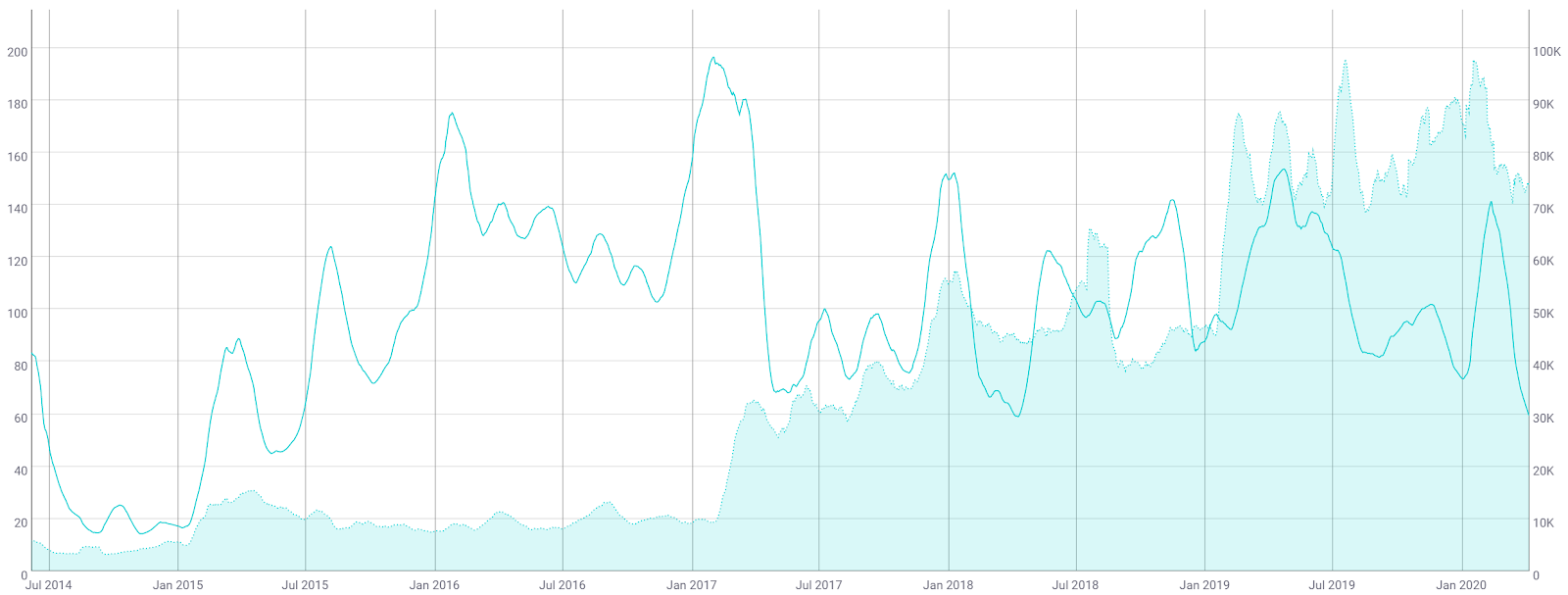
The market cap divided by the realized cap (MVRV) is another crypto-native fundamental metric used to assess overbought or oversold conditions (fill, chart below). Realized cap approximates the value paid for all coins in existence by summing the market value of coins at the time they last moved on the blockchain.
Historically, periods of an MVRV less than 0.5 have represented oversold conditions, whereas periods of an MVRV greater than three have represented overbought conditions. The December 2017 all-time high (line, chart below) also represented an all-time high in MVRV. The MVRV is currently 0.39, suggesting the increasing likelihood of additional upside. However, DASH’s on-chain mixing service likely contributes to a historically low MVRV.
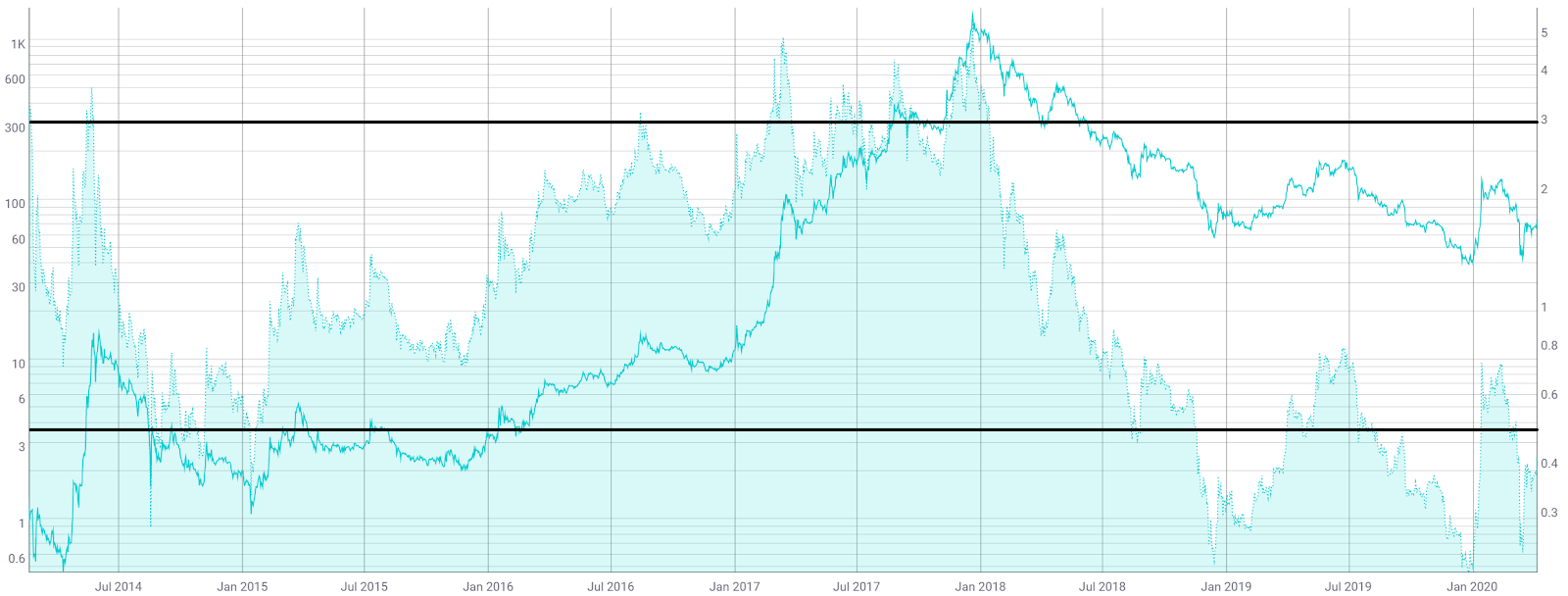
Turning to developer activity, over 100 developers have contributed over 1,000 commits to the 33 DASH Github repos in the past year. All but five of these repos are mostly inactive.
The protocol repo (top, chart below) has had over 600 commits in the past year from nine developers. The DASH Improvement Proctol repo has largely been inactive over the past year (bottom, chart below). DASH Core v0.15 was released in February with improvements to the native UI, mempool syncing, and PrivateSend. Electrum, Android, and iOS wallets are also updated regularly.
Most coins use the developer community of GitHub where files are saved in folders called "repositories," or "repos," and changes to these files are recorded with "commits," which save a record of what changes were made, when, and by who. Although commits represent quantity and not necessarily quality, a higher number of commits can signify higher dev activity and interest.


DASH Exchange traded volume is dominated by Tether (USDT) and Bitcoin (BTC) on Binance, OKEx, and Huobi. Through 2019, DASH has had several listings and delistings.
CEX.io delisted DASH pairs in August 2019 and UpBit followed suit at the end of September 2019, both likely due to regulatory concerns surrounding coins that enable private transactions. OKEx Korea is also considering the same course of action, for the same reasons.
Meanwhile, DASH pairs were added to Coinbase in mid-September 2019, and Binance.US added DASH pairs in October 2019. The Brave Browser, which enables seamless micropayments for publishers and content creators, also added DASH as a payment option in 2019.
Custodial solutions include both Trezor and Ledger hardware wallets, as well as Abra, Electrum, and Jaxx mobile wallets. BitGo also enabled DASH staking in October 2019. On the UpHold wallet service, DASH was the most popular cryptocurrency from January 2018 to January 2019. In April 2019, the spend.com app also announced support on the Spend Visa card.
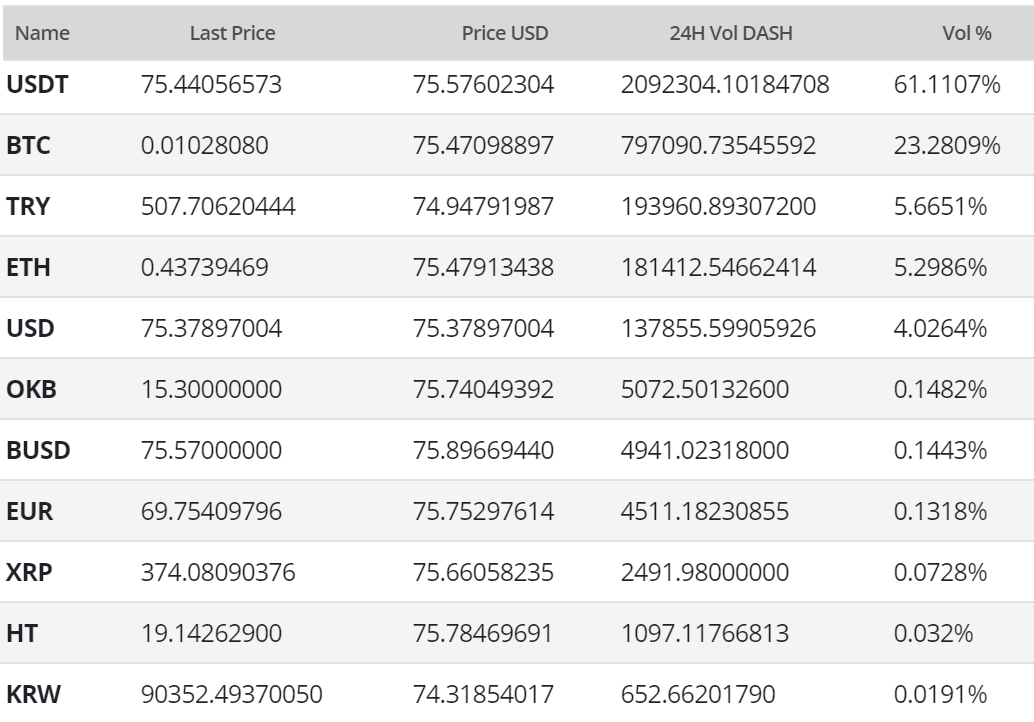
Aside from a brief period in late 2017, Google Trends data for the term "DASH" has mostly been pinned to the floor. The increase in 2017 likely signaled a large swath of new market participants at that time. A 2015 study found a strong correlation between the google trends data and bitcoin price, while a 2017 study concluded that when the U.S. Google "bitcoin" searches increase dramatically, bitcoin price drops.

Technical Analysis
Since the beginning of the year, DASH has moved in line with the broader crypto market, first moving 286% from the December lows, then giving back all those gains to make a new multi-year low on March 12th. Potential roadmaps for upcoming price movements can be found on high timeframes using Exponential Moving Averages, volume profiles, chart patterns, and Ichimoku Cloud. Further background information on the technical analysis discussed below can be found here.
On the DASH/USDT daily chart, the 50-day Exponential Moving Averages (EMA) and 200-day EMA have been bearishly crossed on March 13th, following a 44-day bullish trend. The 200-day EMA, currently at US$83, should now act as resistance. There are no active bullish or bearish divergences at this time.
Significant volume resistance (horizontal bars, chart below) also sits at the US$90 - US$100 zone, with significant support between the US$65 - US$80 zone. Any further upside will likely find resistance at local highs and psychological zones of US$100, US$150, and US$200.
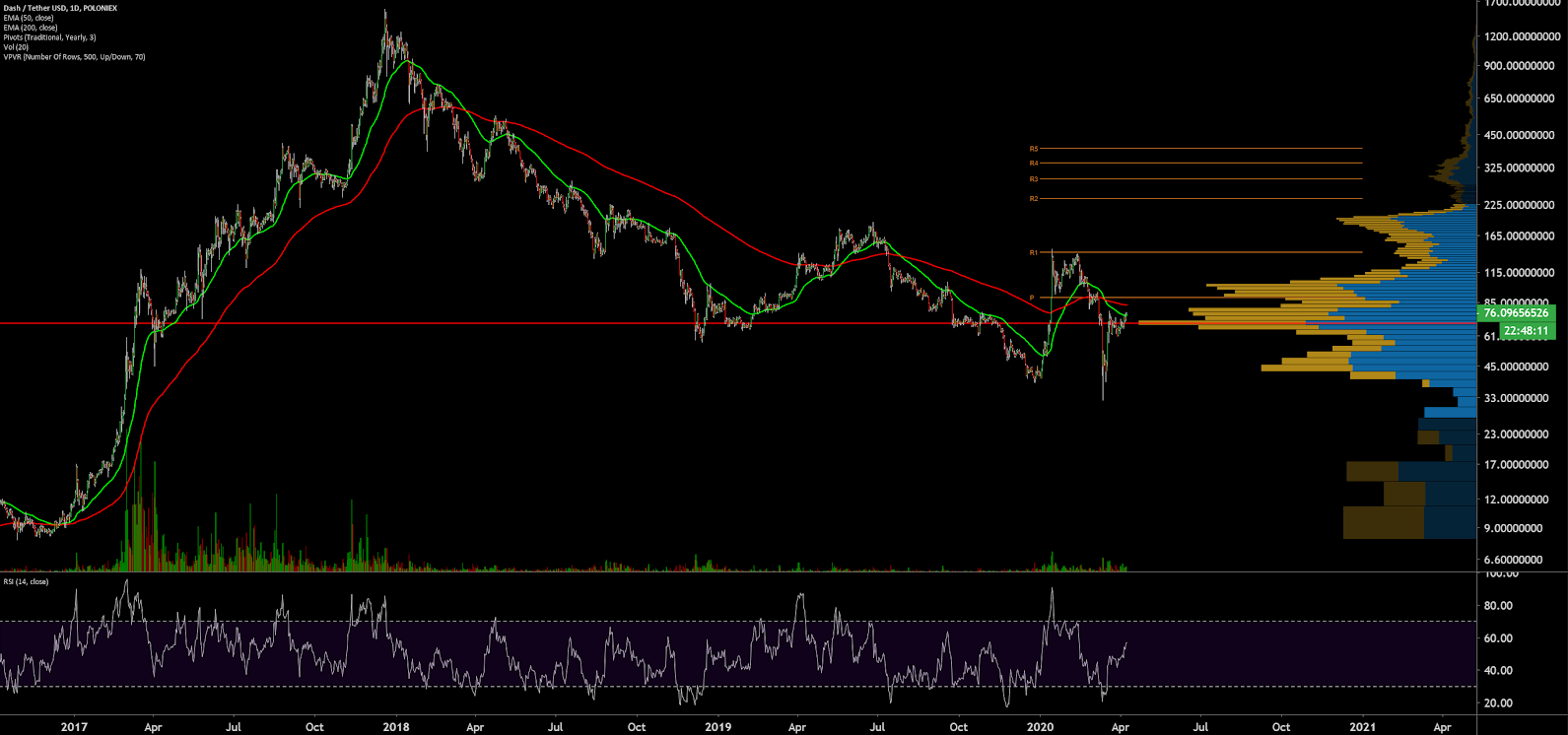
Turning to the Ichimoku Cloud, four metrics are used to indicate if a trend exists; the current price in relation to the Cloud, the color of the Cloud (red for bearish, green for bullish), the Tenkan (T) and Kijun (K) cross, and the Lagging Span. The best entry always occurs when most of the signals flip from bearish to bullish, or vice versa.
The status of the current Cloud metrics on the daily time frame with doubled settings (20/60/120/30), for more accurate signals, are bearish; the spot price is below the Cloud, the Cloud is bearish, the TK cross is bearish, and the Lagging Span is below the Cloud and near the current spot price. The trend will remain bearish so long as price remains below the Cloud. A long flat Kumo at US$88 should act as a magnet for price.
Since the March 12th drop, price has nearly completed an Adam and Eve double bottom. The hallmarks of this pattern include a descending volume profile with V and U-shaped price action. Volume typically increases once resistance is broken. Kumo breakouts are also typically preceded with a bullish or bearish reversal pattern.
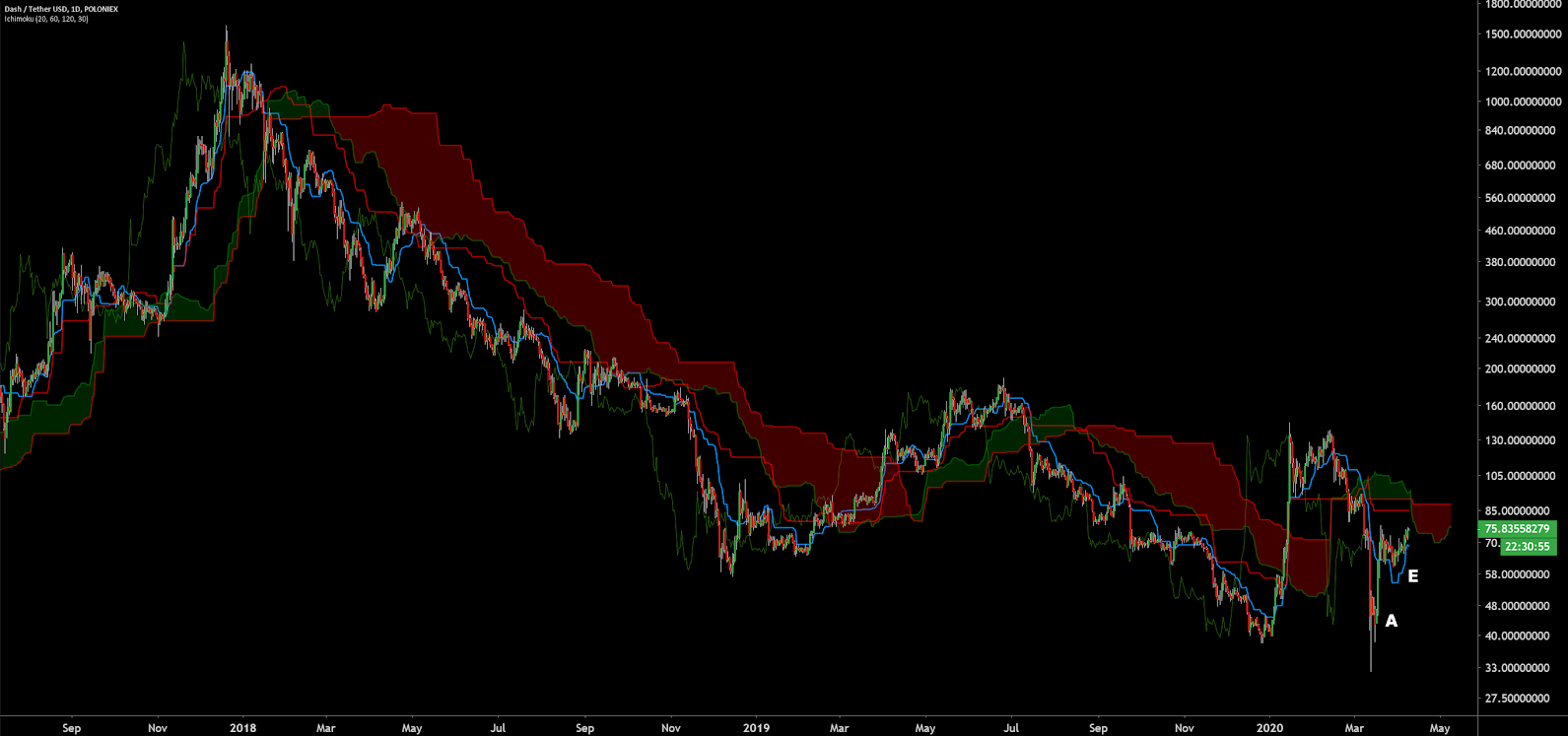
For the DASH/BTC pair, trend indicators show an indeterminate trend with price snaking in and out of the historic high volume zone (horizontal bars, chart below). Since March 2018, the 50-day and 200-day EMAs have essentially remained bearishly crossed. Breaking above the 0.005 to 0.025 zone previously required 1,000 days of consolidation. Based on VPVR a long consolidation period through the 0.01 BTC to 0.017 BTC zone will likely be necessary before any further higher highs.
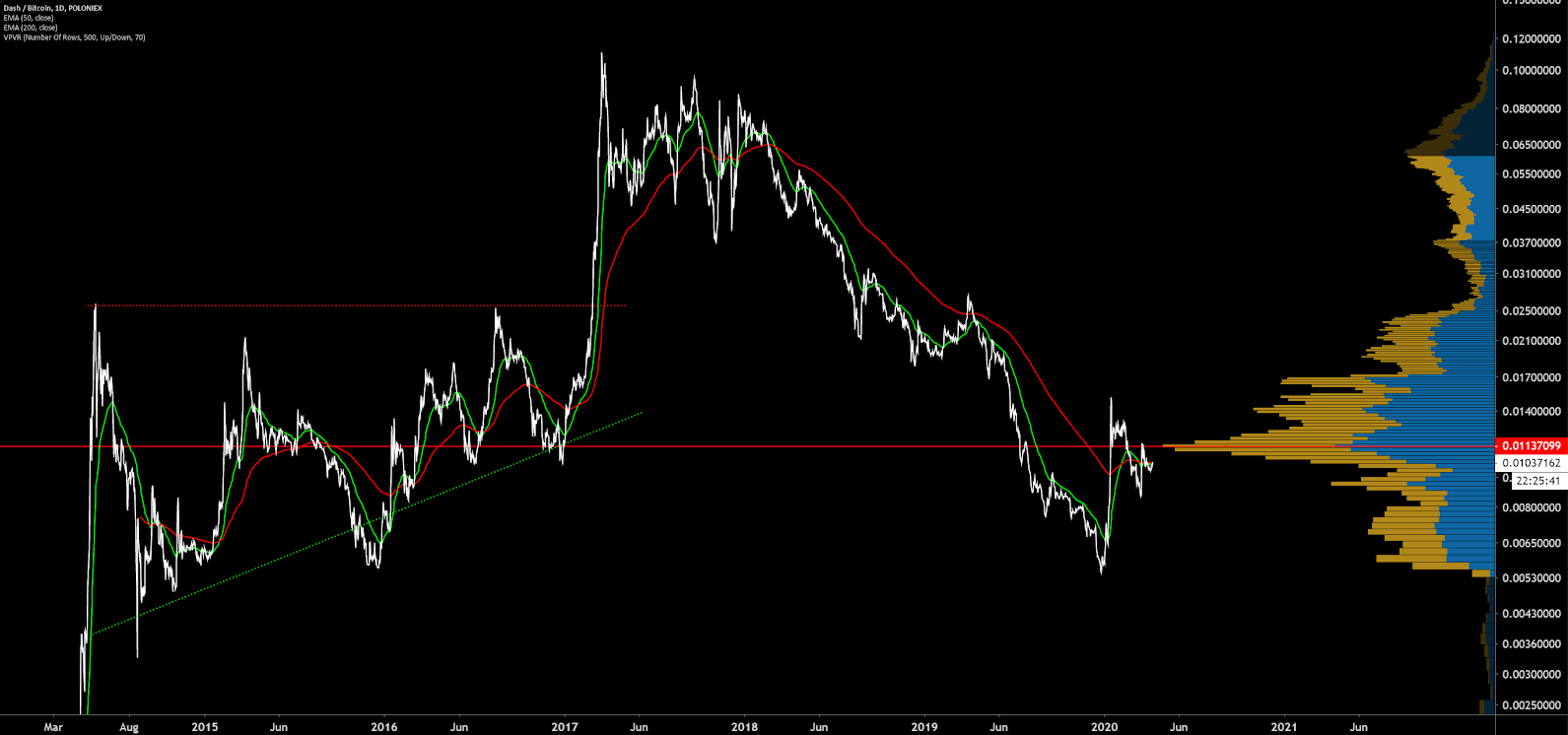
Conclusion
Fundamentals suggest increasing and sustained on-chain activity over the past two years. While optional privacy features are not predominant on the network, these types of transactions have also increased year over year since inception. Protocol development continues, with a recent release in february which brought improvements to the native UI, mempool syncing, and PrivateSend.
Unlike other coins from the class of 2014, which have largely gone extinct, DASH has likely survived due to both the Master Node and treasury components. Master Nodes discourage a vast majority of the circulating supply to ever see the open market, and the treasury has continued to fund DASH related development and marketing to sustain the coin over the past six years.
Technicals for both the DASH/USD and DASH/BTC pairs suggest an indeterminate trend with a successful mean reversion following the drop on March 12th. Over the next few weeks, DASH/USD should push above US$88 and potentially regain bullish momentum. Any further upside will likely find resistance at local highs and psychological zones of US$100, US$150, and US$200. The DASH/BTC pair has over six years of price history, which suggests extended periods of consolidation will be necessary before any further higher highs above 0.016 BTC.
OhNoCrypto
via https://www.ohnocrypto.com
Josh Olszewicz, Khareem Sudlow
